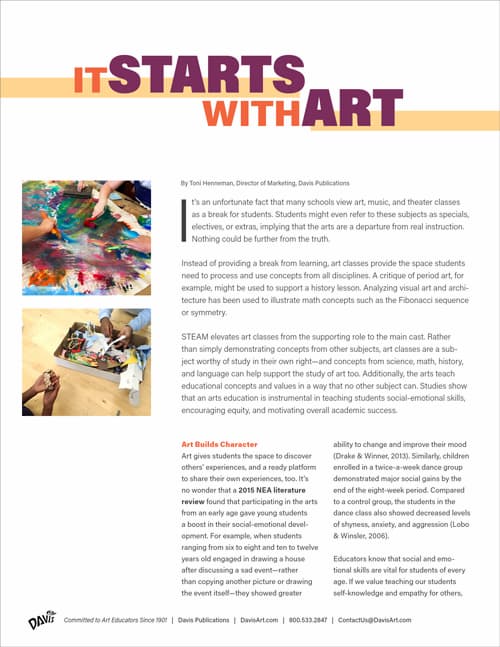It Starts with Art
It’s an unfortunate fact that many schools view art, music, and theater classes as a break for students. Students might even refer to these subjects as specials, electives, and extras, implying that the arts are a departure from real instruction. Nothing could be further from the truth.

Instead of providing a break from learning, art classes provide the space students need to process and use concepts from all disciplines. A critique of period art, for example, might be used to support a history lesson. Analyzing visual art and architecture has been used to illustrate math concepts, such as the Fibonacci sequence or symmetry.
STEAM elevates art classes from the supporting role to the main cast. Rather than simply demonstrating concepts from other subjects, art classes are a subject worthy of study in their own right—and concepts from science, math, history, and language can help support the study of art too. Additionally, the arts teach educational concepts and values in a way that no other subject can. Studies show that an arts education is instrumental in teaching students social-emotional skills, encouraging equity, and motivating overall academic success.
Art Builds Character
Art gives students the space to discover others’ experiences, and a ready platform to share their own experiences, too. It’s no wonder that a 2015 NEA literature review found that participating in the arts from an early age gave young students a boost in their social-emotional development. For example, when students ranging from six-to-eight and ten-to-twelve years old engaged in drawing a house after discussing a sad event—rather than copying another picture or drawing the event itself—they showed greater ability to change and improve their mood (Drake & Winner, 2013). Similarly, children enrolled in a twice-a-week dance group demonstrated major social gains by the end of the eight-week period. Compared to a control group, the students in the dance class also showed decreased levels of shyness, anxiety, and aggression (Lobo & Winsler, 2006).
Educators know that social and emotional skills are vital for students of every age. If we value teaching our students self-knowledge and empathy for others, the arts can take us there. Arts education doesn’t just help us understand the world—it helps us live in it.
Art Encourages Equity
As educators around the country work to ensure that every student succeeds, it’s important to recognize the impact of students’ socioeconomic status on their exposure to the arts. Fran Smith, author of the Edutopia article Why Arts Education Is Crucial, and Who’s Doing It Best, explains it perfectly: “From Mozart for babies to tutus for toddlers to family trips to the museum, the children of affluent, aspiring parents generally get exposed to the arts whether or not public schools provide them. Low-income children, often, do not.”
By prioritizing an arts education within our schools, educators help level the playing field. Arts educators, then, become central players in providing opportunities to at-risk and underprivileged students. A 2012 NEA report found that at-risk high schoolers who engaged in intensive art programs had a number of academic benefits compared to their peers. For example, an arts background was correlated with better academic outcomes, higher career goals, and more civic engagement. Even better: while the studies reviewed by the NEA for this report focused on the effects of art on low SES students, the findings showed that students of high and low economic backgrounds all benefitted from arts education.
Art Supports Academic Success
Even educators who tacitly support arts education might still hesitate to give it the same priority as math or literacy instruction. After all, while a well-balanced school day might benefit students day-to-day, will art or music class really lead to success in the same way that “academic” subjects do?
Absolutely! In fact, making art instruction a priority in a student’s school day is more likely to boost their overall academic achievement. For example, according to the NEA report, “Students with access to the arts in high school were three times more likely than students who lacked those experiences to earn a bachelor’s degree (17 percent versus five percent).” Similarly, the report found that students with an arts education background were more likely to choose a professional major in college and go into a field such as law, medicine, education, or management. It seems that highly prioritizing art education is synonymous with highly prioritizing academic achievement.
Changing the perception of art classes from “supporting role” to “leading lady” in a student’s education can take some adjustment, but it’s a change well worth the effort. Arts education helps students build social-emotional skills, encourages equity, and supports overall academic success. Teaching these values aren’t electives or extras—they’re essential to our students’ education.
Interested in learning more about the importance of art across a student’s education? Check out these additional resources from SchoolArts magazine:
The Quest for Empathy in Art Education
Drafted Buildings
Connecting with Identity and Place
The Drop-In Art Studio
References
2015 NEA Literature Review
Why Arts Education Is Crucial, and Who’s Doing It Best
NEA Research
Arts education doesn’t just help us understand the world—it helps us live in it.
Download a printable PDF of It Starts with Art.



Comments